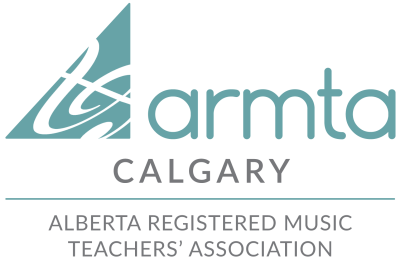High School Accreditation for Private Music Study
Around 2015 or so, ARMTA persuaded Alberta Education to re-instate actual marks from exams rather than the pass/fail they had instituted for all courses taken outside the system curriculum.
A revised Alberta Transcript of High School Achievement is in place.
• This revised transcript includes a new section for ‘Private Music Evaluations’ defined as credits and marks awarded for private music studies completed through an non-Alberta accredited school, including The Royal Conservatory.
• With this change, The Royal Conservatory marks are reported in the ‘Private Music Evaluations’ section on the Alberta Transcript of High School Achievement. Both the percentage mark and the credits awarded by an Alberta school principal will appear on the transcript and will be considered for credentialing.
• Students with previous private music study evaluations and corresponding credits may wish to have their mark updated to include a percentage mark, versus a ‘P’ for ‘pass’. In this case, students are required to contact the school principal to have their marks updated. Once updated by the principal, the student’s transcript will report a percentage mark accordingly.
• For more information on the revised Alberta Transcript of High School Achievement visit: https://open.alberta.ca/publications/how-to-read-and-authenticate-a-transcript.
The school principal can recommend credits and a percentage mark after a student provides an official transcript issued by Conservatory Canada or the Royal Conservatory of Music. Information can be found here: https://manuals.alberta.ca/guide-to-education/program-planning-courses-and-programs/music-private-study/.
To obtain course credit and have the course mark reported, students must pass both the practical and theory components listed in the chart for that course level. A student must provide transcripts with both practical and theory exam marks for the grades/levels specified in the chart. They will be awarded with credits as well as percentage marks based upon the 70 practical/30 theory per cent calculation.
Students who present a transcript for Grade/Level 8 but not for previous grades will receive waived prerequisite credits for Instrumental Music (or Choral Music) 10 and 20 but will not receive percentage marks for these courses.
When a student requests music credits for private study, in voice or an instrument, a principal may grant 5 credits for each of:
• Choral Music 10 for voice
• Choral Music 20 for voice
• Choral Music 30 for voice
• Instrumental Music 10 for an instrument
• Instrumental Music 20 for an instrument
• Instrumental Music 30 for an instrument
In addition to awarding course credit, principals will recommend a percentage mark earned by the student through private music study.
Principals are to recommend credits and a percentage mark only on the basis of official transcripts issued by Conservatory Canada or the Royal Conservatory of Music. Diplomas, photocopies of diplomas or photocopies of transcripts will not be accepted for evaluation purposes.
To obtain course credit and have the course mark reported, students are to have passed both the practical and theory components listed in the table below for that course level.
Marks submitted by schools to Alberta Education should be calculated for each course as follows:
• Practical Component – 70% of mark submitted
• Other Components (Theory) – 30% of mark submitted
A student may receive a maximum of 5 credits per course. Students may not receive credit for participation in private music study and Alberta coursework (for example, a maximum of 15 credits total may be earned in Instrumental Music by a student).
Upon entrance to senior high school, credits and percentage marks for work completed in previous years within private music study can be applied to Instrumental or Choral Music 10, 20 and/or 30 following prerequisite course procedures. For example, if a student provides transcripts with both practical and theory exam marks for the grades/levels specified in the table below, they will be awarded with credits as well as percentage marks based upon the 70/30% calculation.
Students who present a transcript for Grade/Level 8 but not for previous grades will receive waived prerequisite credits for Instrumental Music (or Choral Music) 10 and 20 but will not receive percentage marks for these courses.
The mark determined by the principal for each music course is to be submitted into PASI.
Table 1. Courses for which credits and marks may be recommended for music taken by private study
| 10-level courses1 | 20-level courses1 | 30-level courses1 | |
|---|---|---|---|---|
Conservatory Canada | Contemporary Idioms (Guitar, Piano, Voice) | Level 6 Practical + Theory 2 | Level 7 Practical + Theory 3 | Level 8 Practical (or higher) + Theory 4 |
Classical (Clarinet, Flute, Guitar, Piano, Trumpet, Violin, Voice) | Grade 6 Practical + Theory 2 | Grade 7 Practical + Theory 3 | Grade 8 Practical (or higher) + Theory 4 | |
Royal Conservatory of Music | Oboe, Bassoon, French Horn, Trombone, Euphonium, Tuba, Percussion, Recorder, Harp | Level 4 Practical + Level 6 Theory (formerly Intermediate Rudiments) | Level 6 Practical + Level 6 Theory (formerly Intermediate Rudiments) | Level 8 Practical (or higher) + Level 8 Theory (formerly Advanced Rudiments) |
Flute, Saxophone, Trumpet, Clarinet, Piano, Violin, Viola, Violoncello, Double Bass, Accordion, Guitar, Voice | Level 6 Practical + Level 6 Theory (formerly Intermediate Rudiments) | Level 7 Practical + Level 7 Theory (formerly Advanced Rudiments) | Level 8 Practical (or higher) + Level 8 Theory (formerly Advanced Rudiments) | |
Harpsichord | Royal Conservatory of Music harpsichord 10-level and 20-level courses are not available | Level 8 Practical (or higher) + Level 8 Theory (formerly Advanced Rudiments) | ||
1All voice courses count as Choral Music 10–20–30 respectively for senior high school credits. All other courses are to be used for Instrumental Music 10–20–30 respectively.
Conservatory Canada and the Royal Conservatory of Music periodically review and update their syllabi. This chart reflects the syllabi available at the time of publication of the Guide.
Last Update February 2025
